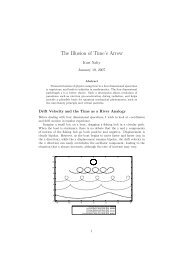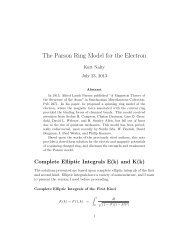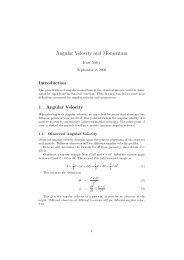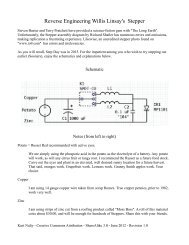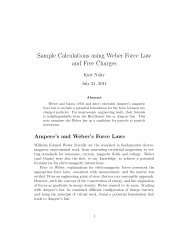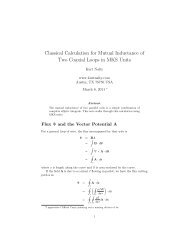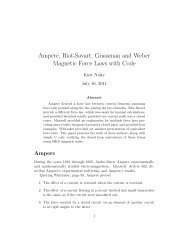Exercises with Magnetic Monopoles - Kurt Nalty
Exercises with Magnetic Monopoles - Kurt Nalty
Exercises with Magnetic Monopoles - Kurt Nalty
You also want an ePaper? Increase the reach of your titles
YUMPU automatically turns print PDFs into web optimized ePapers that Google loves.
Electron Motion in a Radial <strong>Magnetic</strong> Field<br />
The force law for a pure electron in an electromagnetic field is<br />
⃗F = q e<br />
(<br />
⃗E + ⃗v × ⃗ B<br />
)<br />
A pure magnetic field can do no work. Force is at right angles to motion,<br />
and results only in a change of direction. Consequently, the speed is constant,<br />
and the velocity and acceleration are always orthogonal.<br />
To describe the motion of the electron, I will use the Frenet-Serret approach,<br />
and identify the curvature and torsion formulas for the electron in<br />
the radial magnetic field. I assume that Newtonian mass and acceleration<br />
still apply in this scenario.<br />
⃗B = µq m ⃗r<br />
4π r 3<br />
⃗F = q e<br />
(⃗v × B ⃗ )<br />
= µq eq m ⃗v × ⃗r<br />
4π r 3<br />
F<br />
⃗a = ⃗ m = µq eq m 1 ⃗v × ⃗r<br />
4π m r 3<br />
We see above that ⃗a is normal to velocity, and see below that speed will<br />
be constant.<br />
⃗a · ⃗v = 0 = 1 d<br />
(⃗v · ⃗v)<br />
2 dt<br />
= 1 dv 2<br />
2 dt<br />
v 2 = const<br />
The magnitude of curvature in three dimensions is<br />
⃗κ =<br />
⃗a × ⃗v<br />
v 3<br />
av sin θ<br />
κ =<br />
v 3<br />
= a for ṽ ⊥ ã<br />
v 2<br />
21




